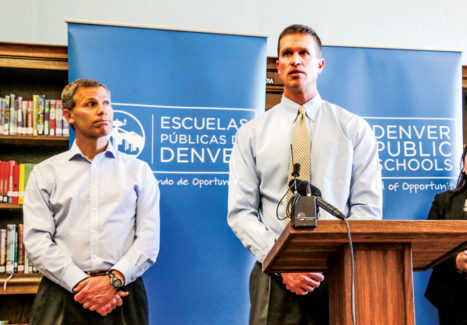
New NE Denver Innovation Zone Executive Director Tomi Amos will be a resident of Stapleton’s Beeler Park neighborhood and is excited to serve the community where she lives.
Four northeast schools with a shared commitment to the International Baccalaureate (IB) programme have been approved by the Denver Board of Education to form an Innovation Zone (iZone). The four schools, Swigert International School, McAuliffe International School, McAuliffe at Manual and Northfield High School will enroll over 3,000 students.
Only the second iZone approved by DPS, the Northeast Denver Innovation Zone (NDIZ) will become operational in August 2018 for a three-year term if approved by the State Board of Education.
- Innovation zones are organized around common interests or geography “as a means to strengthen programming and deepen program continuity, in order to accelerate outcomes for students,” according to DPS. The new iZone formed in Northeast Denver is organized around the IB programme, which is already in place at the four schools.
- Innovation zones offer greater autonomy and flexibility in their governance. According to McAuliffe International School Principal Kurt Dennis, “Forming an innovation zone basically creates a new governance model for our schools.” Schools in an iZone collaborate together but have more flexibilities regarding many district policies. The iZone forms a 501(c)3 nonprofit that is governed by a board of directors and guided by an executive director hired by the board. Principals at the four schools will report to the executive director, rather than to a DPS instructional superintendent, as they do now. The board has recently hired Tomi Amos from the Colorado Department of Education to serve as executive director. The iZone board is accountable to the DPS Superintendent and to the Denver Board of Education, but decisions about curriculum, budgeting, scheduling and other issues are made by the Innovation Zone organization, its board and its principals, independently of the district.
- Innovations zones are more community driven than traditional schools because of their governance structure. “Innovation zones are fundamentally about educator-designed learning communities,” according to a DPS memo in support of the NDIZ plan. “They afford leaders and teachers across a set of schools the opportunity to design and sustain a shared learning community specifically tailored to the needs of their students and communities, and the adults who serve them.”
Why is it a good idea to create this Innovation Zone?
DPS put out a request for proposals in January, offering innovation schools the opportunity to apply for iZone status. According to a statement from DPS Superintendent Tom Boasberg, “We want…talented educators who have great ideas to have the opportunity to try those ideas, learn what works and what doesn’t, accelerate our rate of improvement and allow the district to learn from best practices.”

McAuliffe International School Principal Kurt Dennis was instrumental in crafting the Northeast Denver Innovation Zone proposal in response to the district’s request for proposals.
Dennis says there were multiple reasons he and the other principals responded to the RFP. “DPS already does such a great job of empowering school leaders, especially at innovation schools . . . but this is taking things to another level.” He says the iZone will have much better vertical integration among elementary, middle and high schools locally, so “kids have an opportunity to learn on a continuum that builds on itself.”
Approximately 70 percent of teachers at the four schools voted to approve the iZone model, and the Denver Board of Education vote was unanimous, suggesting strong support for the plan.
Will the Innovation Zone affect enrollment patterns for the included schools?
No. The iZone and the enrollment zone are two entirely different organizing principles. Families will continue to use DPS SchoolChoice system and there will be no priority for continuing in iZone schools. The iZone, “doesn’t necessitate or mandate a feeder pattern… there are opportunities for students to choice in to schools at any point in their career,” says Amos, “And if they continue from (iZone) school to (iZone) school then there’s at least consistency…”
It sounds like a charter network. What makes it different?
In some ways, an Innovation Zone is like a hybrid between a charter school network and district run schools. “What’s different about this [from charter schools] is they’re all still DPS schools, and so we’re talking about neighborhood schools,” says Amos. “The difference is that they have a little more autonomy and flexibility than a traditional public school would, and that’s just based on their innovation status.”
Adds Dennis, “It’s different from a charter school in that we are still fully a part of Denver Public Schools. The board that oversees our 501(c)3 is beholden to the superintendent and the elected Denver Board of Education.”
For charter schools, DPS authorizes charters and holds them accountable to district and state standards but doesn’t operate them or directly oversee them.
What kinds of budget flexibilities will the iZone have?
Colorado spends an average of $9,575 per student (putting it in 39th place nationally, according to recent data). Schools in DPS operate on this “Student Based Budget” (SBB), and principals at the school level have some flexibility in how they spend parts of that money. But many services provided by DPS central administration have traditionally been mandatory, with fees to pay for them coming from the school’s SBB, regardless of whether the schools need those services.
In the iZone, principals are given added discretion to opt out of certain central administration services, according to Dennis, more than innovation schools alone can do. For example, “We’re an innovation school and we don’t use the district math curriculum. We have our own math curriculum,” says Dennis. DPS charges schools about $24 per student for its math curriculum. “As a typical innovation school, you would be paying that $24 per kid, even if you’re not using that service,” says Dennis. “So what we’re saying is, ‘We’re not using the service. Please allow us to keep the money, and we’re going to apply it toward something else.’”
Each principal can make the decisions for its own school. Dennis anticipates that McAuliffe will opt out of about $200/student of district services, just a little over 2% of the budget. “It is a small piece of the pie but, to us, $300,000 is five teachers,” he said. With its new budgetary discretions, for example, Northfield High plans to purchase the services of a math intervention teacher and additional social and emotional support services, he added.
Who will serve on the board for the Innovation Zone?
The non-profit board that oversees the iZone currently includes seven members. All board members live locally and have been active in education as parents, educators, or school leaders, said Dennis. “Teachers are going to have representation to say, ‘This is how we need to operate to maximize the outcomes that our students can achieve,’” says Amos.
The board will meet regularly, with the community invited to participate.
Will any other schools be added?
Down the road, additional schools can be added to the zone. “Scale obviously provides greater and increased opportunity for flexibility and financial freedom,” says Amos. “But I think first steps first—really just understanding the community and making sure they really understand the opportunity before diving in to expansion.”
The first iZone in Denver, the Luminary Learning Network, was approved in 2015 and added Valdez Elementary as the fifth school in its network beginning in 2018. Dennis said that they might consider adding on additional IB schools if there is interest and it makes sense for the iZone.


0 Comments